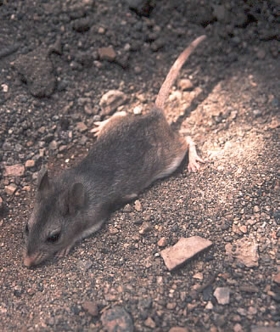Southern grasshopper mouse
| Southern grasshopper mouse | ||||||||||||
|---|---|---|---|---|---|---|---|---|---|---|---|---|

Southern grasshopper mouse ( Onychomys torridus ) |
||||||||||||
| Systematics | ||||||||||||
|
||||||||||||
| Scientific name | ||||||||||||
| Onychomys torridus | ||||||||||||
| ( Coues , 1874) |
The southern grasshopper mouse ( Onychomys torridus ) is a rodent (Rodentia) from the family of the burrowers (Cricetidae) living in North and Central America .
features
The southern grasshopper mouse reaches a total length of 120 to 163 millimeters, of which the relatively short and thick tail makes up about a third. Their fur is gray to cinnamon-colored on the top and white on the underside. The basal two thirds of the tail are colored like the upper body, the underside and the tip of the tail are each white. The tooth formula is I 1 / 1- C 0 / 0- P 0 / 0- M 3/3. The diploid number of chromosomes is 48.
Similar species
Similar animals from the genus of grasshopper mice ( Onychomys ) differ primarily in their different skull and jaw structures.
distribution and habitat
The distribution area of the southern grasshopper mouse extends over the west and southwest of the USA and the north of Mexico . They primarily inhabit hot, dry valleys and bush deserts, such as the Chihuahua Desert and the Sonoran Desert . Onychomys torridus is not uncommon in their biotopes and is therefore classified by the IUCN as a " Least Concern ".
Way of life
The southern grasshopper mouse lives in small burrows that are dug into the ground. Often these burrows were abandoned by other rodents, sometimes even conquered by force. It is one of the most aggressive predators , which is generally unusual for mice. She is mostly nocturnal, active all year round, good climber, but mostly moves on the ground. Preferred prey animals are grasshoppers (Gomphocerinae) and scorpions (Scorpiones), in particular the Arizona bark scorpion ( Centruroides vittatus ). The mouse is able to neutralize the effects of the scorpion poison as far as possible. The poison reacts with certain chemical compounds it forms, which then block the transmission of pain signals. The grasshopper mouse does not become insensitive to the scorpion poison itself, but to the pain. The food spectrum also includes white-footed mice ( Peromyscus ), silk pocket mice ( Perognathus ), small voles ( Microtus ), harvest mice ( Reithrodontomys ) and even representatives of their own species . It kills its prey with a targeted bite in the head. Vegetable food in the form of berries and seeds is only consumed in small quantities.
The southern grasshopper mouse usually lives solitary and aggressively defends its territory against intruders. If males and females live together, one of the two partners is often killed and eaten if there is a lack of food. One unusual behavior is called "howling". The animals produce a loud, piercing sound that is held between 0.7 and 1.2 seconds, repeated several times and can still be heard by the human ear at a distance of up to 100 meters. You stand upright on your hind legs with your nose stretched upwards. Apparently, this serves as a warning to competitors. The behavior is sometimes reminiscent of a miniature wolf howl .
The mice can reproduce all year round, but mostly give birth in late spring and summer. The gestation period is 26 to 35 days. The litter size ranges from one to six young animals, which weigh about 2.6 grams at birth. They open their eyes at two weeks of age and are weaned at three weeks of age.
Individual evidence
- ^ A b c Richard McCarty: Mammalian Species Onychomys torridus , Mammalian Species No. 59, The American Society of Mammalogists, 1975, pp. 1-5
- ^ IUCN Red List
- ↑ Ashlee H. Rowe, Matthew P. Rowe: Physiological resistance of grasshopper mice (Onychomys spp.) To Arizona bark scorpion (Centruroides exilicauda) venom. In: Toxicon . Volume 52, No. 5, 2008, pp. 597-605.
- ↑ Daniel Lingenhöhl: A grasshopper mouse knows no pain Spektrum.de from January 14, 2013 (accessed on December 12, 2020)
literature
- Ronald M. Nowak: Walker's Mammals of the World. 2 volumes. 6th edition, Johns Hopkins University Press, Baltimore / London, 1999, ISBN 0-8018-5789-9 .
Web links
- ITIS report - taxonomy
